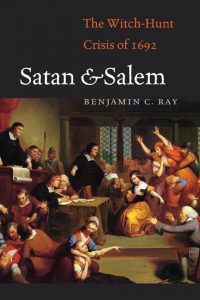Satan and Salem by Benjamin C. Ray
 Ray, Benjamin C. Satand and Salem: The Witch-Hunt Crisis of 1692. Charlottesville: University of Virginia Press, 2015. 252 pp. $29.95/£27.95.
Ray, Benjamin C. Satand and Salem: The Witch-Hunt Crisis of 1692. Charlottesville: University of Virginia Press, 2015. 252 pp. $29.95/£27.95.
Benjamin C. Ray chronicles the events of the Salem witch-hunt (1692) in his recent monograph, Satan and Salem. This historical work relies heavily upon primary records, including depositions, case records, along with historical testimony from pastoral journals and published works written in response to or in mediation of the crisis. Rather than structuring this history diachronically, Ray elects to arrange his account by topic. These topics include people, places, and pivotal events related to the crisis. One advantage of this approach is that, though some of the history is repeated, the repetition locks the events into readers’ minds, helping them situate the history from a meta-perspective, which allows many different ideas to become part of an interconnected web rather than a linear path.
Ray’s approach is not to re-interpret the events from a post-modern mindset that benefits from today’s psychological and sociological study. His desire is not to speculate about the real reason why events unfolded or to critique the pre-critical mindset of his subjects. He did not set out to undermine colonial metaphysical understanding and deny the spiritual conflict taking place. Rather he aims to enter into the colonial context of 1692 and permit the subjects to speak from their own understanding about what took place. For instance, he does not cast doubt upon the afflicted’s testimony—those young women who accused many of witchcraft due to the affliction they experienced—but Ray allows their testimony to bear itself out.
Though the study is chronicled by topic, the arrangement does have an eye towards the actual chronology of the events. Ray begins by looking at Samuel Parris, the newly arrived pastor at Salem. Ray reflects on Parris’s initiative to protect the sacraments from the halfway covenant, and his efforts through preaching and relational alliances to consolidate authority and power within the Salem village’s meetinghouse. This meant arousing people’s guilt for not aspiring to membership and participation in the Supper. Samuel Parris’s sermons, arouse minds to think upon the spiritual conflict and see a spiritual battle between Satan and Christ in Salem village, which very well serves as a catalyst for what soon comes.
When the first accusations and affliction occur it is the testimony of Tituba, Parris’s slave, that catapults the town into frenzy. Her testimony of spectral manifestations, conversations with specters, and initial witness to the witchcraft activity sets the course for how the afflictions of Abigail Williams, Ann Putnam Jr., Mary Wilcott, Mercy Lewis, Elizabeth Hubbard, and Mary Warren would soon be interpreted. Ray indicates that these young women appear to have genuine afflictions, regardless of motive, according to the accounts of second-hand witnesses and their own testimony. Yet, one is left wondering if the pricking of pins, the touch test, or the actual displays of affliction are staged out of a desire for attention, self-preservation, or a fanatical sense of being in the throes of this spectacular drama. Ray’s chapter on the magistrates seems to indicate that perhaps these young women were merely playing their part from a desire to please authority figures, and, perhaps, a fear of being caught in a lie.
The chapter on the witch meetings and the progression of the hunt in Andover accomplishes two aims for readers. One, it helps them understand the popular lore on witchcraft during the seventeenth-century and the provenance of some of this lore. Also, it helps one see how exaggerated and accelerated the accounts become—to the point where the stories foster a panic involving a meta-narrative where Satan wishes to destroy Christ’s kingdom in New England. Possibly the most outlandish part of the matter is that all of these witch-gatherings near Parris’s home are either spectral accounts or confessions. No outside first-hand witnesses come forward who are not complicit in the events themselves.
I found Ray’s account to be riveting. He does an excellent job of helping the reader understand the sincerity of all the people involved in the witchhunt. Though it appears that he is fairly biased towards his favorite interpreters, such as Thomas Brattle. He could have given readers more of the interpretive thought of the Cottons; I would have liked more on their publications, which I will likely skim later. It was interesting to see how the father and son, Increase and Cotton respectively, had different reads on the events and fell into different groups—Increase wishing the trials and acceptance of spectral evidence to cease and Cotton endorsing the continuation of trials and use of spectral accounts as evidence.
Perhaps it is what is left unsaid that left this reader most disappointed. But it is possible that the author intentionally left this gaping hole, so that he could come around and do another work entirely dedicated to the project left untouched, which is this: the stories and experiences of those who would not confess to witchcraft, who in turn were executed; these people were left mostly as enigmas. What little Ray gives concerning their testimonies and last words is extremely moving. Nonetheless, these people, who were marched out to Proctor’s Ledge and hung, remain as but apparitions and specters to readers. Truly, I imagine a chapter could be dedicated to each of the tortured and executed.
Finally, I appreciate the effort Ray took to talk about how Salem’s history is exploited for the sake of tourism. The chapter on mapping out Salem was very interesting. I also found the ultimate conclusion of regret, admission of “mistakes”, expunging the prosecuteds’ records, and reparations for their families to be compelling. The historical retelling itself, with its final outcome, paints the picture that something was clearly not right about the whole trial process.
